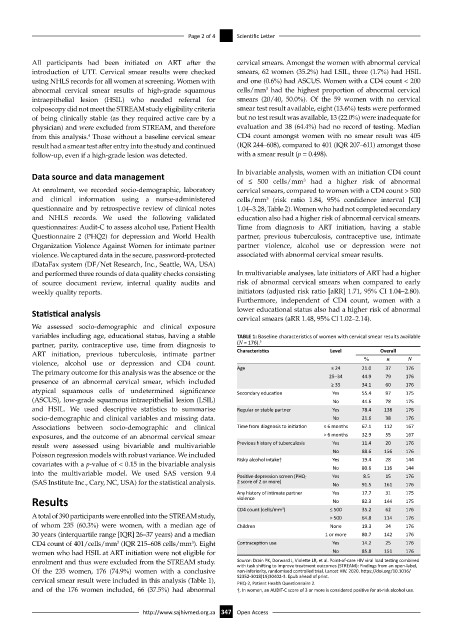Page 355 - HIVMED_v21_i1.indb
P. 355
Page 2 of 4 Scientific Letter
All participants had been initiated on ART after the cervical smears. Amongst the women with abnormal cervical
introduction of UTT. Cervical smear results were checked smears, 62 women (35.2%) had LSIL, three (1.7%) had HSIL
using NHLS records for all women at screening. Women with and one (0.6%) had ASCUS. Women with a CD4 count < 200
3
abnormal cervical smear results of high-grade squamous cells/mm had the highest proportion of abnormal cervical
intraepithelial lesion (HSIL) who needed referral for smears (20/40, 50.0%). Of the 59 women with no cervical
colposcopy did not meet the STREAM study eligibility criteria smear test result available, eight (13.6%) tests were performed
of being clinically stable (as they required active care by a but no test result was available, 13 (22.0%) were inadequate for
physician) and were excluded from STREAM, and therefore evaluation and 38 (64.4%) had no record of testing. Median
from this analysis. Those without a baseline cervical smear CD4 count amongst women with no smear result was 405
4
result had a smear test after entry into the study and continued (IQR 244–608), compared to 401 (IQR 207–611) amongst those
follow-up, even if a high-grade lesion was detected. with a smear result (p = 0.498).
Data source and data management In bivariable analysis, women with an initiation CD4 count
of ≤ 500 cells/mm had a higher risk of abnormal
3
At enrolment, we recorded socio-demographic, laboratory cervical smears, compared to women with a CD4 count > 500
and clinical information using a nurse-administered cells/mm (risk ratio 1.84, 95% confidence interval [CI]
3
questionnaire and by retrospective review of clinical notes 1.04–3.28, Table 2). Women who had not completed secondary
and NHLS records. We used the following validated education also had a higher risk of abnormal cervical smears.
questionnaires: Audit-C to assess alcohol use, Patient Health Time from diagnosis to ART initiation, having a stable
Questionnaire 2 (PHQ2) for depression and World Health partner, previous tuberculosis, contraceptive use, intimate
Organization Violence Against Women for intimate partner partner violence, alcohol use or depression were not
violence. We captured data in the secure, password-protected associated with abnormal cervical smear results.
iDataFax system (DF/Net Research, Inc., Seattle, WA, USA)
and performed three rounds of data quality checks consisting In multivariable analyses, late initiators of ART had a higher
of source document review, internal quality audits and risk of abnormal cervical smears when compared to early
weekly quality reports. initiators (adjusted risk ratio [aRR] 1.71, 95% CI 1.04–2.80).
Furthermore, independent of CD4 count, women with a
Statistical analysis lower educational status also had a higher risk of abnormal
cervical smears (aRR 1.48, 95% Cl 1.02–2.14).
We assessed socio-demographic and clinical exposure
variables including age, educational status, having a stable TABLE 1: Baseline characteristics of women with cervical smear results available
partner, parity, contraceptive use, time from diagnosis to (N = 176). 5
ART initiation, previous tuberculosis, intimate partner Characteristics Level % Overall N
n
violence, alcohol use or depression and CD4 count.
≤ 24
The primary outcome for this analysis was the absence or the Age 25–34 21.0 37 176
44.9
176
79
presence of an abnormal cervical smear, which included ≥ 35 34.1 60 176
atypical squamous cells of undetermined significance Secondary education Yes 55.4 97 175
(ASCUS), low-grade squamous intraepithelial lesion (LSIL) No 44.6 78 175
and HSIL. We used descriptive statistics to summarise Regular or stable partner Yes 78.4 138 176
socio-demographic and clinical variables and missing data. No 21.6 38 176
Associations between socio-demographic and clinical Time from diagnosis to initiation ≤ 6 months 67.1 112 167
exposures, and the outcome of an abnormal cervical smear > 6 months 32.9 55 167
result were assessed using bivariable and multivariable Previous history of tuberculosis Yes 11.4 20 176
Poisson regression models with robust variance. We included No 88.6 156 176
28
covariates with a p-value of < 0.15 in the bivariable analysis Risky alcohol intake† Yes 19.4 116 144
80.6
No
144
into the multivariable model. We used SAS version 9.4 Positive depression screen (PHQ- Yes 8.5 15 176
(SAS Institute Inc., Cary, NC, USA) for the statistical analysis. 2 score of 2 or more) No 91.5 161 176
Any history of intimate partner Yes 17.7 31 175
Results violence No 82.3 144 175
CD4 count (cells/mm ) 3 ≤ 500 35.2 62 176
A total of 390 participants were enrolled into the STREAM study, > 500 64.8 114 176
of whom 235 (60.3%) were women, with a median age of Children None 19.3 34 176
30 years (interquartile range [IQR] 26–37 years) and a median 1 or more 80.7 142 176
CD4 count of 401/cells/mm (IQR 215–608 cells/mm ). Eight Contraception use Yes 14.2 25 176
3
3
women who had HSIL at ART initiation were not eligible for No 85.8 151 176
enrolment and thus were excluded from the STREAM study. Source: Drain PK, Dorward J, Violette LR, et al. Point-of-care HIV viral load testing combined
with task shifting to improve treatment outcomes (STREAM): Findings from an open-label,
Of the 235 women, 176 (74.9%) women with a conclusive non-inferiority, randomised controlled trial. Lancet HIV. 2020. https://doi.org/10.1016/
cervical smear result were included in this analysis (Table 1), S2352-3018(19)30402-3. Epub ahead of print.
PHQ-2, Patient Health Questionnaire 2.
and of the 176 women included, 66 (37.5%) had abnormal †, In women, an AUDIT-C score of 3 or more is considered positive for at-risk alcohol use.
http://www.sajhivmed.org.za 347 Open Access

